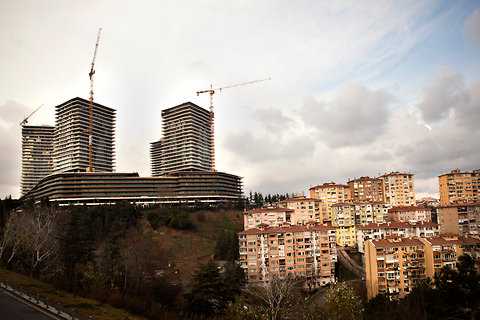
Kerem Uzel/Bloomberg News
ISTANBUL — Here’s a bit of hyperbole I’m prepared to defend: the Yenikapi district of Istanbul, located along the Sea of Marmara, is one of the most important historical sites on earth. In 2004 excavations for a major subway station uncovered the harbor of Byzantium and a treasure trove of objects, including 36 boats. The ships’ cargo alone offered a unique guide to medieval life around the Mediterranean Sea.
“Our generation’s discovery of the pyramids” is how the Harvard University history professor Michael McCormick once described the finds to me. The same excavations also uncovered 8,000-year-old human remains from the Late Neolithic period — evidence that the area was inhabited even before the Bosphorus Strait was formed, dividing the land into what we now call Europe and Asia.
Now here’s a bit of hyperbole I wish I didn’t have to defend: the damage now being done to Istanbul rivals the damage done to Constantinople by the Fourth Crusade. The so-called Latin invaders of 1202 looted Byzantium in the name of religion; today the city is being pillaged in the name of progress and profit.
I should temper my criticism. Like many great cities, Istanbul faces the challenge of squeezing the vast infrastructural requirements of a modern metropolis into the narrow alleys of its ancient past. To their credit, after the finds of 2004, city authorities made the painful decision of delaying the construction of a much-needed metro system to allow archaeologists to conduct excavations first.
And again, to its credit, in 2010 the municipal government organized an international competition for the redevelopment of Yenikapi with a view to building not only a new subway station and tunnel but also archaeological parks that would showcase what for millennia had laid buried under the city. A three-way tie was declared in mid-April, and the co-winners, all well-known international architecture consortia, were asked to put their heads together and come up with a joint plan.
But then, on orders from the central government, the municipality dropped a bomb: it announced as a fait accompli a plan to fill in about 2.8 square miles of the waters off Yenikapi to create an assembly ground for political rallies and outdoor fairs. This vast space will be big enough to accommodate 800,000 people, perhaps even one million.
Wanting to add some bulbous growth to the side of the peninsula of Istanbul is a folly so grand it’s hard to take seriously. It’s like wanting to straighten the Seine or turn the Colosseum into a football stadium.
Related in Opinion
Op-Ed: Turkey’s Hypocrisy
Turkey must atone for its own past crimes before lecturing others on human rights, writes Taner Akcam.
Read the Op-Ed in Turkish »
Why would anyone contemplate building a monstrous wasteland within hailing distance of masterworks like Hagia Sofia or the Blue Mosque? No one really knows the answer because the Yenikapi project was cooked up in some backroom in Ankara without a shred of public consultation (let alone an environmental impact study).
One explanation, so banal as to be plausible, is that there is so much digging and tunneling going on around Istanbul that contractors need somewhere to dump the debris.
Another explanation is that the project is a display of rank power — the Erdogan government’s latest attempt to leave a visible mark on Istanbul. It is doing it because it can.
Andrew Finkel has been a foreign correspondent in Istanbul for over 20 years, as well as a columnist for Turkish-language newspapers. He is the author of the book “Turkey: What Everyone Needs to Know.”
via Destroying Istanbul – NYTimes.com.

Leave a Reply